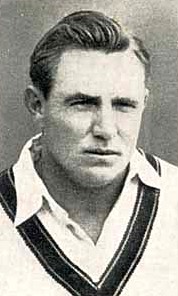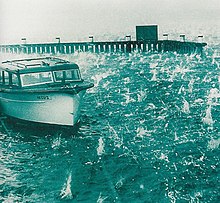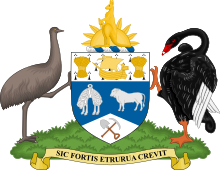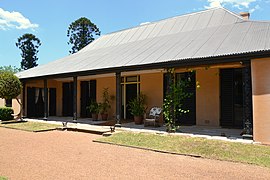Portal:New South Wales
Portal maintenance status: (June 2018)
|
The New South Wales Portal


New South Wales (commonly abbreviated as NSW) is a state on the east coast of Australia. It borders Queensland to the north, Victoria to the south, and South Australia to the west. Its coast borders the Coral and Tasman Seas to the east. The Australian Capital Territory and Jervis Bay Territory are enclaves within the state. New South Wales' state capital is Sydney, which is also Australia's most populous city. In December 2023[update], the population of New South Wales was over 8.3 million, making it Australia's most populous state. Almost two-thirds of the state's population, 5.3 million, live in the Greater Sydney area.
The Colony of New South Wales was founded as a British penal colony in 1788. It originally comprised more than half of the Australian mainland with its western boundary set at 129th meridian east in 1825. The colony then also included the island territories of Van Diemen's Land, Lord Howe Island, and Norfolk Island. During the 19th century, most of the colony's area was detached to form separate British colonies that eventually became the various states and territories of Australia. The Swan River Colony (later called the Colony of Western Australia) was never administered as part of New South Wales. (Full article...)
 Recognized content - load new batch
Recognized content - load new batch 
-
Image 1
Raymond Russell Lindwall MBE (3 October 1921 – 23 June 1996) was an Australian cricketer who represented Australia in 61 Tests from 1946 to 1960. He is widely regarded as one of the greatest fast bowlers of all time. He also played top-flight rugby league football with St. George, appearing in two grand finals for the club before retiring to fully concentrate on Test cricket.
A right-arm fast bowler of express pace, Lindwall was widely regarded as the greatest pace bowler of his era and one of the finest of all time. He modelled his action on the great England fast bowler Harold Larwood. Together with Keith Miller, Lindwall formed a new-ball pairing regarded as one of the greatest to have played cricket. Lindwall was known for his classical style, with a smooth and rhythmic run-up and textbook side-on bowling action, from which he generated his trademark outswinger which moved away late at high pace. Lindwall mixed his outswinger with a searing yorker, subtle changes of pace and an intimidating bouncer that skidded at the heads of opposing batsmen. Later in his career, Lindwall developed an inswinger, which together with his variety, pace and control made him the most feared paceman of his time. (Full article...) -
Image 2Molly Morgan (baptised 31 January 1762 – 27 June 1835) was an English landowner, farmer, and convict. She was born as Mary Jones in Ludlow, Shropshire, England, and stayed there throughout her childhood and early adulthood, marrying William Morgan on 25 June 1785 and having two children with him. In 1789, hempen yarn stolen from a factory was discovered at the Morgans' house, resulting in the couple being sentenced to penal transportation. Although William was able to escape initially, Molly was transported to New South Wales as a convict with the Second Fleet on the Neptune, and William was eventually caught and transported as well. After working together for a while in Australia, William left Molly due to her flirting with other men. In 1794, Molly Morgan was able to escape back to England aboard the Resolution by becoming Captain John Locke's mistress. Once back in England, she recovered her children and became a dressmaker in Plymouth, marrying Thomas Mears in 1797. However, she was transported back to Australia on the Experiment, after she was accused of burning her husband's house down in 1803.
When Morgan returned to Australia, she acquired land and cattle. In 1814, she was sentenced to seven years in jail for milking a stolen cow. However, by 1819, she was trusted enough to be one of the twelve convicts given several acres of land to farm at Wallis Plains (now Maitland), and was set free by 1822. She married Thomas Hunt on 5 March 1822. She started a wine shanty on the land she was given at Wallis Plains and received a grant of additional land by the governor, Thomas Brisbane, where she built the Angel Inn. By 1828, she was described as "one of the largest landholders on the Hunter River" and had several features in New South Wales named after her. Morgan also aided other settlers several times, including donating money to help build a school, turning part of her home into a hospital, and riding to Sydney on behalf of convicts. Her wealth significantly decreased throughout the later years of her life and she died on 27 June 1835, at Anvil Creek in Greta, New South Wales, where she owned 203 acres (82 ha) of land. (Full article...) -
Image 3
Snowy Mountains Highway is a 333-kilometre-long (207 mi) state highway located in New South Wales, Australia. Its two sections connect the New South Wales South Coast to the Monaro region, and the Monaro to the South West Slopes via the Snowy Mountains. The higher altitude regions of this road are subject to snow over the winter months, and the road also provides access to many parts of the Snowy Mountains Scheme. The highway bears the B72 shield along its entire length.
The highway originally bore the name Monaro Highway until 1955, when it received its current name. It originally ran from Tathra to Wagga Wagga but has been shortened to run from Princes Highway to Hume Highway instead. Reservoirs created as a result of dams built in the 1950s and 1960s as part of the Snowy Mountains Scheme required the creation of major realignments to avoid submerged areas. Previous to New South Wales' conversion to alphanumeric route markers, it was signed as National Route 18. (Full article...) -
Image 4

The Eastern Suburbs & Illawarra Line (numbered T4, coloured azure blue) is a commuter railway line on the Sydney Trains network in the eastern and southern suburbs of Sydney. The line was constructed in the 1880s to Wollongong to take advantage of agricultural and mining potentials in the Illawarra area. In March 1926, it became the first railway in New South Wales to run electric train services.
Today, the railway consists of three connected lines:- The original Illawarra line from the Sydney CBD to Waterfall
- The Cronulla line from Sutherland to Cronulla, which opened in 1939 replacing an earlier tram service
- The Eastern Suburbs line from the Sydney CBD to Bondi Junction, which opened in 1979
-
Image 5A boat at Rose Bay in water which is being churned by the hailstones.
The 1947 Sydney hailstorm was a natural disaster which struck Sydney, Australia, on 1 January 1947. The storm cell developed on the morning of New Year's Day, a public holiday in Australia, over the Blue Mountains, hitting the city and dissipating east of Bondi in the mid-afternoon. At the time, it was the most severe storm to strike the city since recorded observations began in 1792.
The high humidity, temperatures and weather patterns of Sydney increased the strength of the storm. The cost of damages from the storm were, at the time, approximately £750,000 (US$3 million); this is the equivalent of around A$45 million in modern figures. The supercell dropped hailstones larger than 8 centimetres (3.1 in) in diameter, with the most significant damage occurring in the central business district and eastern suburbs of Sydney. (Full article...) -
Image 6
Reginald Walter Darcy Weaver (18 July 1876 – 12 November 1945) was an Australian conservative parliamentarian who served in the New South Wales Legislative Assembly for 28 years. Serving from 1917 in the backbenches, he entered the cabinet of Thomas Bavin in 1929 as Secretary for Mines and Minister for Forests until he returned to opposition in 1930. Following the success of the United Australia Party in the 1932 election, Weaver returned as the Secretary for Public Works and Minister for Health in the Stevens ministry.
In 1935 he was dropped from the ministry but was later elected as the Speaker of the New South Wales Legislative Assembly in 1937, holding office until the Mair Government lost power in 1941. Weaver then witnessed the death of the United Australia Party in 1943 and became the leader of the new Democratic Party in 1944. He was then involved in the negotiations to form the New South Wales branch of the Liberal Party, with Weaver becoming the first leader of the state Liberal Party in April 1945. He served only briefly until dying of a heart attack in November 1945. (Full article...) -
Image 7
Ernest Raymond Herbert Toshack (8 December 1914 – 11 May 2003) was an Australian cricketer who played in 12 Tests from 1946 to 1948. A left arm medium paced bowler known for his accuracy and stamina in the application of leg theory, Toshack was a member of Don Bradman's "Invincibles" that toured England in 1948 without being defeated. Toshack reinforced the Australian new ball attack of Ray Lindwall and Keith Miller.
Born in 1914, Toshack overcame many obstacles to reach international level cricket. He was orphaned as an infant, and his early cricket career was hindered because of financial difficulties caused by the Great Depression. The Second World War prevented Toshack from competing at first-class level until he was into his thirties. In 1945–46, the first season of cricket after the end of the War, Toshack made his debut at first-class level and after only seven matches in the Sheffield Shield he was selected for Australia's tour of New Zealand. In Wellington, he opened the bowling in a match that was retrospectively classed as an official Test match. Toshack became a regular member of the Australian team, playing in all of its Tests until the 1947–48 series against India. He took his career-best match bowling figures of 11 wickets for 31 runs (11/31) in the First Test but began to suffer recurring knee injuries, and a medical board had to approve his selection for the 1948 England tour. Toshack played in the first four Tests before being injured. After a long convalescence, he attempted a comeback during Australia's 1949–50 season, but further injury forced him to retire. He was a parsimonious bowler, who was popular with crowds for his sense of humour. (Full article...) -
Image 8Banksia oblongifolia,
Georges River National Park
Banksia oblongifolia, commonly known as the fern-leaved, dwarf or rusty banksia, is a species in the plant genus Banksia. Found along the eastern coast of Australia from Wollongong, New South Wales in the south to Rockhampton, Queensland in the north, it generally grows in sandy soils in heath, open forest or swamp margins and wet areas. A many-stemmed shrub up to 3 m (9.8 ft) high, it has leathery serrated leaves and rusty-coloured new growth. The yellow flower spikes, known as inflorescences, most commonly appear in autumn and early winter. Up to 80 follicles, or seed pods, develop on the spikes after flowering. Banksia oblongifolia resprouts from its woody lignotuber after bushfires, and the seed pods open and release seed when burnt, the seed germinating and growing on burnt ground. Some plants grow between fires from seed shed spontaneously.
Spanish botanist Antonio José Cavanilles described B. oblongifolia in 1800, though it was known as Banksia aspleniifolia in New South Wales for many years. However, the latter name, originally coined by Richard Anthony Salisbury, proved invalid, and Banksia oblongifolia has been universally adopted as the correct scientific name since 1981. Two varieties were recognised in 1987, but these have not been generally accepted. A wide array of mammals, birds, and invertebrates visit the inflorescences. Though easily grown as a garden plant, it is not commonly seen in horticulture. (Full article...) -
Image 9

John Rowland Dacey (1 June 1854 – 11 April 1912) was an Irish-born Australian politician. He moved to Victoria, Australia, with his mother after his father died. Eventually orphaned, Dacey moved to Sydney with his wife and began working as a coachmaker. He began his involvement in politics with an election to local council then moved to the New South Wales Legislative Assembly from 24 June 1895 to his death on 11 April 1912, serving as Treasurer in his final two years.
Throughout his parliamentary career, Dacey campaigned for a garden suburb which would provide government-owned, low-cost housing to the working class. After his death, the garden suburb of Daceyville was built in Sydney and named in honour of him. (Full article...) -
Image 10

Persoonia levis, commonly known as the broad-leaved geebung, is a shrub native to New South Wales and Victoria in eastern Australia. It reaches 5 m (16 ft) in height and has dark grey papery bark and bright green asymmetrical sickle-shaped leaves up to 14 cm (5.5 in) long and 8 cm (3.2 in) wide. The small yellow flowers appear in summer and autumn (December to April), followed by small green fleshy fruit, which are classified as drupes. Within the genus Persoonia, it is a member of the Lanceolata group of 58 closely related species. P. levis interbreeds with several other species where they grow together.
Found in dry sclerophyll forest on sandstone-based nutrient-deficient soils, P. levis is adapted to a fire-prone environment; the plants resprout epicormic buds from beneath their thick bark after bushfires, and can live for over 60 years. Regeneration also takes place after fire by a ground-stored seed bank. The longtongue bee Leioproctus carinatifrons is a pollinator of the flowers, and the fruit are consumed by vertebrates such as kangaroos, possums and currawongs. Despite its horticultural appeal, P. levis is rare in cultivation as it is very hard to propagate, either by seed or cuttings. (Full article...) -
Image 11HMCS Integrity was a cutter built by the Colonial Government of New South Wales in 1804. She was the first vessel ever launched from a New South Wales dockyard and carried goods between the colony's coastal settlements of Norfolk Island, Newcastle, New South Wales, Van Diemen's Land and Port Jackson. In 1804 she took part in a series of voyages to Van Diemen's Land with the aim of founding a colony at Port Dalrymple, the site of the modern settlement of George Town, Tasmania.
In 1805 Integrity encountered and recaptured a Spanish brig which had been unlawfully seized by privateers and concealed in the Kent Group of islands in Bass Strait. Having returned the Spanish vessel to colonial control, Integrity was designated the task of sailing to Chile to negotiate its return to Spain. She set sail for Valparaíso, Chile, in June 1805, but was not seen again and is likely to have foundered during the voyage. (Full article...) -
Image 12
Lester Joseph Brain, AO, AFC (27 February 1903 – 30 June 1980) was a pioneer Australian aviator and airline executive. Born in New South Wales, he trained with the Royal Australian Air Force (RAAF) before joining Queensland and Northern Territory Aerial Services (Qantas) as a pilot in 1924. He was awarded the Air Force Cross in 1929, after locating the lost aircraft Kookaburra in northern Australia. Having risen to Chief Pilot at Qantas by 1930, he was appointed Flying Operations Manager in 1938. As a member of the RAAF reserve, Brain coordinated his airline's support for the Australian military during World War II. He earned a King's Commendation for his rescue efforts during an air raid on Broome, Western Australia, in 1942, and was promoted to wing commander in 1944.
Seeing little prospect for advancement at Qantas once the war had ended, Brain left to join the fledgling government-owned domestic carrier Trans Australia Airlines (TAA) in June 1946. Appointed its first General Manager, he swiftly built up the organisation to the stage where it could commence scheduled operations later in the year. By the time he resigned in March 1955, TAA was firmly established as one half of the Commonwealth government's two-airline system. After his departure from TAA, Brain became Managing Director of de Havilland Aircraft in Sydney, before joining the board of East-West Airlines as a consultant in January 1961. He was appointed an Officer of the Order of Australia in January 1979 and died in June the following year, aged seventy-seven. (Full article...) -
Image 13
Bronwyn Bancroft AM (born 1958) is an Aboriginal Australian artist, administrator, book illustrator, and among the first three Australian fashion designers to show their work in Paris. She was born in Tenterfield, New South Wales, and trained in Canberra and Sydney.
In 1985, Bancroft established a shop called Designer Aboriginals, selling fabrics made by Aboriginal artists, including herself. She was a founding member of Boomalli Aboriginal Artists Co-operative. Her artwork is held by the National Gallery of Australia, the Art Gallery of New South Wales and the Art Gallery of Western Australia. She illustrated and written 47 ;children's books, including Stradbroke Dreamtime by activist Oodgeroo Noonuccal, and books by artist Sally Morgan. Her design commissions include one for the exterior of a Sydney sports centre. (Full article...) -
Image 14
Maddison Gae Elliott, OAM (born 3 November 1998) is an Australian swimmer. At the 2012 Summer Paralympics in London, she became the youngest Australian Paralympic medallist by winning bronze medals in the women's 400 m and 100 m freestyle S8 events. She then became the youngest Australian gold medallist when she was a member of the women's 4 × 100 m freestyle relay 34 points team. At the 2016 Rio Paralympics, she won three gold and two silver medals. (Full article...) -
Image 15
Grevillea juniperina, commonly known as juniper- or juniper-leaf grevillea or prickly spider-flower, is a plant of the family Proteaceae native to eastern New South Wales and southeastern Queensland in Australia. Scottish botanist Robert Brown described the species in 1810, and seven subspecies are recognised. One subspecies, G. j. juniperina, is restricted to Western Sydney and environs and is threatened by loss of habitat and housing development.
A small, prickly-leaved shrub between 0.2–3 m (0.66–9.84 ft) high, G. juniperina generally grows on clay-based or alluvial soils in eucalypt woodland. The flower heads, known as inflorescences, appear from winter to early summer and are red, orange or yellow. Birds visit and pollinate the flowers. Grevillea juniperina plants are killed by bushfire, regenerating afterwards from seed. Grevillea juniperina adapts readily to cultivation and has been important in horticulture as it is the parent of many popular garden hybrids. (Full article...)
Selected image

| Credit: David Iliff |
The koala is found in coastal regions of eastern and southern Australia, from near Adelaide to the southern part of Cape York Peninsula. Populations also extend for considerable distances inland in regions with enough moisture to support suitable woodlands. The koala is the national animal emblem of New South Wales.
Related portals
WikiProjects
Selected articles - load new batch
-
Image 1
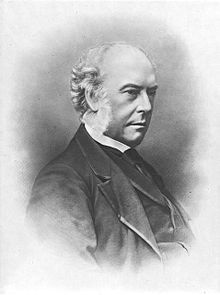
The first Cowper ministry was the second ministry of the Colony of New South Wales, and was led by Charles Cowper. It was the first of five occasions that Cowper was Leader of the Government. Cowper was elected in the first free elections for the New South Wales Legislative Assembly held in March 1856, and fought unsuccessfully with Stuart Donaldson to form Government. When Donaldson's Government faltered a little over two months after it was formed, Cowper formed Government.
The title of Premier was widely used to refer to the Leader of Government, but not enshrined in formal use until 1920. (Full article...) -
Image 2Cabbage Tree Island may refer to three locations in New South Wales, Australia:
- Cabbage Tree Island, New South Wales, a settlement in Ballina Shire
- Cabbage Tree Island (John Gould Nature Reserve), an island and nature reserve near Port Stephens
- Cabbage Tree Island, near Old Bar in the Manning River Entrance State Park, NSW
-
Image 3The Pratt truss spans of the 1929 Tom Uglys Bridge, as viewed from the north
Tom Uglys Bridge are two road bridges, completed in 1929 and 1987, that carry the Princes Highway across the Georges River in southern Sydney, in the state of New South Wales, Australia. The bridges link the St George area at Blakehurst to the Sutherland Shire at Sylvania. Tom Uglys Bridge is one of six major road crossings of Georges River.
across the Georges River in southern Sydney, in the state of New South Wales, Australia. The bridges link the St George area at Blakehurst to the Sutherland Shire at Sylvania. Tom Uglys Bridge is one of six major road crossings of Georges River.
The 1929 Pratt truss bridge is listed on the New South Wales State Heritage Register and carries three lanes of northbound vehicular traffic on the Princes Highway. The 1987 concrete box girder bridge was built to the east of the older bridge and carries the three southbound lanes of the highway. Both bridges have shared bicycle and pedestrian pathways. (Full article...) -
Image 4Mountain ranges surrounding Mount Kosciuszko.
The Snowy Mountains, known informally as "The Snowies", is an IBRA subregion in southern New South Wales, Australia, and is the tallest mountain range in mainland Australia, being part of the continent's Great Dividing Range cordillera system. It makes up the northeastern half of the Australian Alps (the other half being the Victorian Alps) and contains Australia's five tallest peaks, all of which are above 2,100 m (6,890 ft), including the tallest Mount Kosciuszko, which reaches to a height of 2,228 m (7,310 ft) above sea level. The offshore Tasmanian highlands makes up the only other major alpine region present in the whole of Australia.
The Snowy Mountains experience large natural snowfalls for several months of the year; with significant accumulation during May, June, July, August, September and October with the snow cover usually melting by November (although it can occasionally persist through high summer and the next autumn). It is considered to be one of the centres of the Australian ski industry during the winter months, with all four snow resorts in New South Wales being located in the region. The range is host to the mountain plum-pine, a low-lying type of conifer. (Full article...) -
Image 5
The Supreme Court of New South Wales is the highest state court of the Australian State of New South Wales. It has unlimited jurisdiction within the state in civil matters, and hears the most serious criminal matters. Whilst the Supreme Court is the highest New South Wales court in the Australian court hierarchy, an appeal by special leave can be made to the High Court of Australia.
Matters of appeal can be submitted to the New South Wales Court of Appeal and Court of Criminal Appeal, both of which are constituted by members of the Supreme Court, in the case of the Court of Appeal from those who have been commissioned as judges of appeal. (Full article...) -
Image 6
The Nightcap National Park is a national park situated within the Nightcap Range in the Northern Rivers region of New South Wales, Australia. The 8,080-hectare (20,000-acre) park was created in April 1983 and is situated 35 kilometres (22 mi) north of Lismore. The park was established following campaigns and blockades against logging at Terania Creek, Grier's Scrub and Mount Nardi between 1979 and 1982. Sections of the Whian Whian state forest were added to it following blockading and campaigning in 1998. The national park is classed by the IUCN World Commission on Protected Areas as Category II and is part of the Shield Volcano Group of the World Heritage Site Gondwana Rainforests of Australia inscribed in 1986 and added to the Australian National Heritage List in 2007. (Full article...) -
Image 7
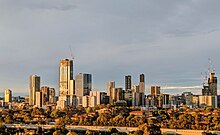
Greater Western Sydney (GWS) is a large region of the metropolitan area of Greater Sydney, New South Wales (NSW), Australia that generally embraces the north-west, south-west, central-west, far western and the Blue Mountains sub-regions within Sydney's metropolitan area and encompasses 11 local government areas: Blacktown, Blue Mountains, Camden, Campbelltown, Cumberland, Fairfield, Hawkesbury, Liverpool, Parramatta, Penrith and Wollondilly. It includes Western Sydney, which has a number of different definitions, although the one consistently used is the region composed of ten local government authorities, most of which are members of the Western Sydney Regional Organisation of Councils (WSROC). The NSW Government's Office of Western Sydney calls the region "Greater Western Sydney".
Radiocarbon dating suggests human activity occurred in the Sydney metropolitan area from around 30,000 years ago. The Darug people lived in the area that was greater western Sydney before European settlement regarded the region as rich in food from the river and forests. Parramatta was founded in 1788, the same year as Sydney, making it the second oldest city in Australia. Opened in 1811, Parramatta Road, which navigates into the heart of greater western Sydney, is one of Sydney's oldest roads and Australia's first highway between two cities – Sydney central business district (CBD) and Parramatta, which is now the sixth largest business district in Australia. Rapid population increase after World War II saw the settlement of many ex-service men and migrants in the greater west, making it one of the most urbanised regions in the country and an area of growing national importance. (Full article...) -
Image 8

Map of rail lines in NSW
The Australian state of New South Wales has an extensive network of railways, which were integral to the growth and development of the state. The vast majority of railway lines were government built and operated, but there were also several private railways, some of which operate to this day. (Full article...) -
Image 9The distinctive crenellated parapet of the Harts Pub, part of Harts Buildings, pictured in 2010.
The Harts Buildings is a heritage-listed hotel and pub and former residence, located at 10–14 Essex Street, in the inner city Sydney suburb of The Rocks in the City of Sydney local government area of New South Wales, Australia. It was built from 1890 to 1899. It is also known as Hart's Buildings. The property is owned by Property NSW, an agency of the Government of New South Wales. It was added to the New South Wales State Heritage Register on 10 May 2002. (Full article...) -
Image 10
Nimbin is a town in the Northern Rivers area of the Australian state of New South Wales, approximately 30 km (19 mi) north of Lismore, 33 km (21 mi) northeast of Kyogle, and 70 km (43 mi) west of Byron Bay.
Nimbin is notable for the prominence of its environmental initiatives such as permaculture, sustainability, and self-sufficiency, as well as the cannabis counterculture. Writer Austin Pick described his initial impressions of the village this way: "It is as if a smoky avenue of Amsterdam has been placed in the middle of the mountains behind frontier-style building facades. ... Nimbin is a strange place indeed." (Full article...) -
Image 11
The Bank of New South Wales (BNSW), also known as The Wales, was the first bank in Australia. It was established in 1817 in Sydney. During the 19th century, the bank opened branches throughout Australia and New Zealand, expanding into Oceania in the 20th century. Throughout it history it merged with and purchased many other financial institutions. In 1981 it merged with the Commercial Bank of Australia and was renamed Westpac on 4 May 1982. (Full article...) -
Image 12
Wodonga (pronounced /wəˈdɒŋɡə/; Pallanganmiddang: Wordonga) is a city on the Victorian side of the border with New South Wales, 324 kilometres (201 mi) north-east of Melbourne, Australia. It is part of the twin city of Albury-Wodonga and is located wholly within the boundaries of the City of Wodonga LGA and is separated from its twin city in New South Wales, Albury, by the Murray River. As of 2021 Wodonga and its suburbs have a population of 38,949 and combined with Albury, the two cities form the urban area Albury-Wodonga with a population of 97,793. There are multiple suburbs of Wodonga including Bandiana, Baranduda, Barnawartha, Bonegilla, Ebden, Huon Creek, Killara, Leneva and Staghorn.
Wodonga produces a gross domestic product of $2.5 billion per year on average. (Full article...) -
Image 13
The Montreal Community Theatre is a heritage-listed cinema and community theatre at 46 Russell Street, Tumut, Snowy Valleys Council, New South Wales, Australia. It was designed by Kaberry & Chard and built from 1929 to 1930. It is also known as Montreal Community Theatre and Moveable Heritage Collection. The property is owned by the Snowy Valleys Council. It was added to the New South Wales State Heritage Register on 21 June 2013. (Full article...) -
Image 14
The Parliament of New South Wales, formally the Legislature of New South Wales, is the bicameral legislative body of the Australian state of New South Wales (NSW). It consists of the monarch, the New South Wales Legislative Assembly (lower house) and the New South Wales Legislative Council (upper house). Each house is directly elected by the people of New South Wales at elections held approximately every four years. The legislative authority of the parliament derives from section 5 of the Constitution Act 1902 (NSW). The power to make laws that apply to New South Wales is shared with the Federal (or Commonwealth) Parliament. The houses of the New South Wales Parliament follow the Westminster parliamentary traditions of dress, green–red chamber colours and protocols. The houses of the legislature are located in Parliament House on Macquarie Street, Sydney. (Full article...) -
Image 15Elizabeth Farm, the first item inscribed on the Register
The New South Wales State Heritage Register, also known as NSW State Heritage Register, is a heritage list of places in the state of New South Wales, Australia, that are protected by New South Wales legislation, generally covered by the Heritage Act 1977 and its 2010 amendments. The register is administered by the Heritage Council of NSW via Heritage NSW, a division of the Government of New South Wales Department of Planning and Environment.
The register was created in 1999 and includes items protected by heritage schedules that relate to the State, and to regional and to local environmental plans. As a result, the register contains over 20,000 statutory-listed items in either public or private ownership of historical, cultural, and architectural value. Of those items listed, approximately 1,785 items are listed as significant items for the whole of New South Wales; with the remaining items of local or regional heritage value. The items include buildings, objects, monuments, Aboriginal places, gardens, bridges, landscapes, archaeological sites, shipwrecks, relics, bridges, streets, industrial structures and conservation precincts. (Full article...)
Did you know (auto-generated)

- ... that in its two years of existence, the Hunter River Railway Company initiated construction on what would eventually become the Great Northern Railway connecting Sydney to Queensland?
- ... that Turkish international soccer player Rojin Polat was named member of the "2021 All Schools Merit Girls Team" in New South Wales, Australia?
- ... that many an Xplorer has traversed the rails in Canberra?
- ... that the rural village of Neath, New South Wales, had a population of three Tok Pisin speakers in 2021?
General images - load new batch
-
Image 1The 5th Governor of New South Wales, Lachlan Macquarie, was influential in establishing civil society in Australia (from History of New South Wales)
-
Image 4Federation Pavilion, Centennial Park, Sydney, 1 January 1901. (from History of New South Wales)
-
Image 5Japanese POW camp at Cowra, shortly before the Cowra breakout (from History of New South Wales)
-
Image 6Humanitarian Caroline Chisholm provided support to poverty-stricken women migrants (from History of New South Wales)
-
Image 7Mr E.H. Hargraves, The Gold Discoverer of Australia, returning the salute of the gold miners - Thomas Tyrwhitt Balcombe, 1851 (from History of New South Wales)
-
Image 8Olympic colours on the Sydney Harbour Bridge in the year 2000 (from History of New South Wales)
-
Image 9Tumut 3 Power Station was constructed as part of the vast Snowy Mountains Scheme in New South Wales (1949–1974). Construction necessitated the expansion of Australia's immigration program. (from History of New South Wales)
-
Image 11World leaders with Prime Minister John Howard in Sydney for the 2007 APEC conference (from History of New South Wales)
-
Image 13A bulk carrier entering the Port of Newcastle, New South Wales, 2009 (from Economy of New South Wales)
-
Image 14Landing of Lieutenant James Cook at Botany Bay, 29 April 1770, by E. Phillips Fox (from History of New South Wales)
-
Image 16The New South Wales Parliament is Australia's oldest parliament. (from History of New South Wales)
-
Image 18William Wentworth was key in the establishment of self-governance in New South Wales (from History of New South Wales)
-
Image 19Founding of the settlement of Port Jackson at Botany Bay in New South Wales in 1788, by Thomas Gosse (from History of New South Wales)
-
Image 20Ribbon ceremony to open the Sydney Harbour Bridge on 20 March 1932. Breaking protocol, the soon to be dismissed Premier Jack Lang cuts the ribbon while Governor Philip Game looks on. (from History of New South Wales)
-
Image 21A General Chart of New Holland including New South Wales & Botany Bay with The Adjacent Countries and New Discovered Lands, published in An Historical Narrative of the Discovery of New Holland and New South Wales, London, Fielding and Stockdale, November 1786 (from History of New South Wales)
-
Image 22A chart of part of the interior of New South Wales by John Oxley, Surveyor General, 1822 (from History of New South Wales)
-
Image 24Dry paddocks in the Riverina region during the 2007 drought (from History of New South Wales)
-
Image 25Hyde Park, Sydney with the Australian Museum under construction in the distance, 1842 (from History of New South Wales)
Topics
Categories
More portals
In the news
- 23 December 2024 –
- A man is arrested and charged with animal cruelty for shooting and killing 98 kangaroos on a military base in Singleton, New South Wales, Australia. (news.com.au)
Associated Wikimedia
The following Wikimedia Foundation sister projects provide more on this subject:
-
Commons
Free media repository -
Wikibooks
Free textbooks and manuals -
Wikidata
Free knowledge base -
Wikinews
Free-content news -
Wikiquote
Collection of quotations -
Wikisource
Free-content library -
Wikiversity
Free learning tools -
Wikivoyage
Free travel guide -
Wiktionary
Dictionary and thesaurus


